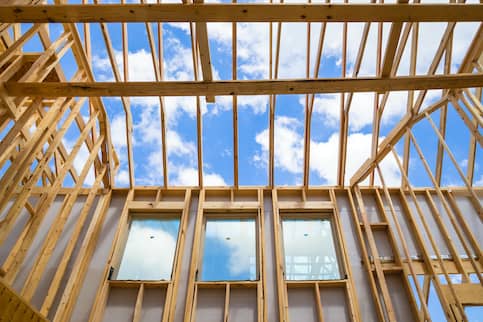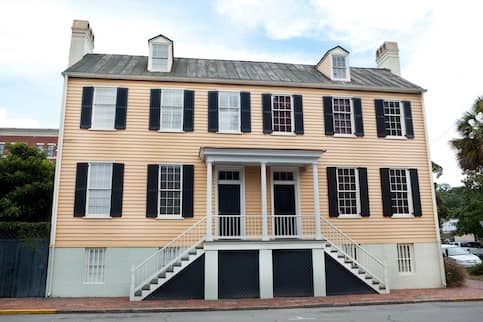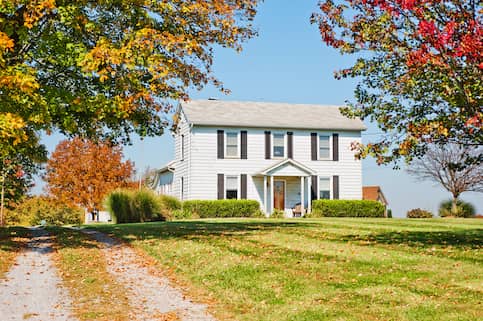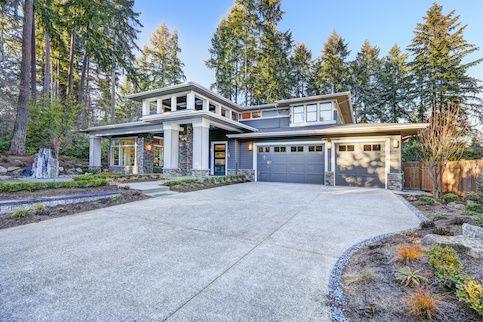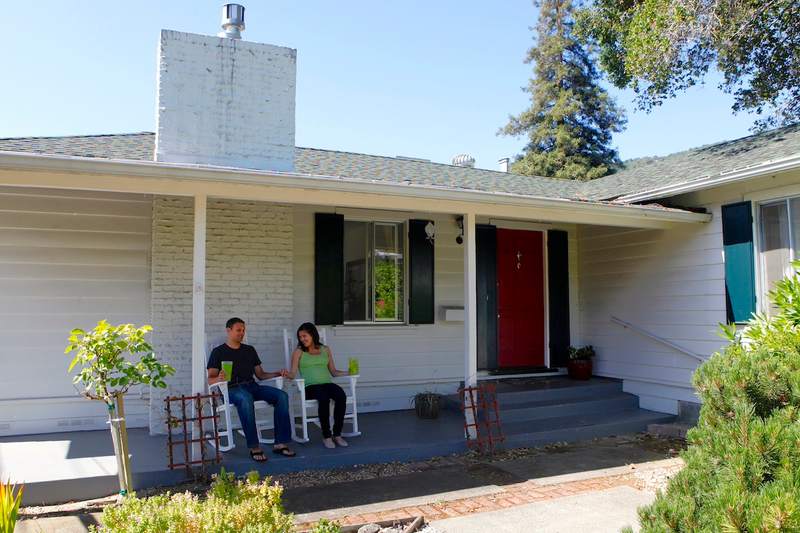Building a home can be expensive. And taking out both a construction loan and primary mortgage to finance this can be challenging. Fortunately, a USDA construction loan can help with both problems. These loans require no down payment, and you’ll only need to close one loan to finance both the construction of your residence and the home itself. There is one drawback, though: You must build a home in what the U.S. Department of Agriculture (USDA) considers a rural area.
What Is A USDA Construction Loan?
As its name suggests, a USDA construction loan is a mortgage loan insured by the USDA and differs from a traditional USDA home loan in that it acts as a construction-to-permanent loan.
USDA loans are attractive because they require no down payment. To qualify for this loan type, though, you’ll need to build in a part of the country considered rural by the USDA.
Though the USDA insures this loan type, the government agency doesn’t originate USDA construction loans. If you want to apply for one of these loans, you’ll need to apply with a private mortgage lender. The challenge? It can sometimes be difficult to find a mortgage lender who originates USDA construction loans.
You can learn more about how these loans work at the USDA’s Single-Family Housing Guaranteed Loan Program home page.
How Does A USDA Construction Loan Work?
Typically, when building a home, you’d need to first take out a construction loan to finance the purchase of your home’s land and the construction of the property. You’d then transition to a permanent mortgage – often a 30-year or 15-year fixed-rate mortgage – and pay back your home loan with regular monthly payments.
The USDA construction loan is different from other types of loans. With the USDA construction loan, you’ll only need to take out one loan total. Your loan will start out as a construction loan. Then, when construction is done, it will transition into a permanent mortgage, usually a fixed-rate loan. You’d then make regular monthly mortgage payments, with interest, to pay back the loan.
See What You Qualify For
Buy A Home
Discover mortgage options that fit your unique financial needs.

Refinance
Refinance your mortgage to have more money for what matters.
Tap Into Equity
Use your home’s equity and unlock cash to achieve your goals.
Pros And Cons Of USDA Construction Loans
As with all mortgage types, there are both advantages and disadvantages to using a USDA construction loan.
USDA Construction Loan Pros
Here are some of the benefits of using a USDA construction loan:
- This loan gives you the opportunity to build a home and finance that home’s purchase in one loan with one closing date. Instead of having to first take out a construction loan and then a mortgage loan, you can apply for a single loan that converts from a construction loan to a standard mortgage loan.
- No down payment. You can qualify for a USDA construction loan with no money down, a benefit to buyers who haven’t built up much savings.
- Flexible requirements, though it will vary by lender. Most lenders will approve you for this loan if your FICO® credit score is at least 640. Your monthly debts, including your new mortgage payments, should also eat up no more than 41% of your gross monthly income.
USDA Construction Loan Cons
A USDA construction loan may come with some drawbacks:
- It can be difficult to find a lender that originates USDA construction loans. You’ll need to shop around until you find a lender willing to work with you.
- Though you won’t have to come up with a down payment, you’ll need to pay upfront and monthly guarantee fees mandated by the USDA. You’ll pay a one-time upfront guarantee fee of 1% of your loan’s total amount when you close your loan. If you’re borrowing $300,000, this fee comes to $3,000. You’ll also pay an annual USDA guarantee fee, which is 0.35% of your loan amount.
- Not all buyers qualify for a USDA construction loan. The USDA requires that you build a home in a designated rural area.
USDA Construction Loan Requirements
Ready to apply for a USDA construction loan? Make sure, first, that you meet these requirements:
Property Requirements
The USDA requires that the home you are building meets several conditions:
- The property must be your primary residence. You are not allowed to use a USDA construction loan to build an investment property or a vacation home.
- The home you build must be in an area that the USDA considers rural. To find out if the area in which you want to build qualifies as rural, use this USDA property look-up tool.
- You must work with a contractor approved by the USDA to build your home.
Borrower Requirements
You must also meet certain credit and income requirements to qualify for a USDA construction loan:
- You will usually need a minimum FICO® credit score of 640 to qualify.
- Your debt-to-income ratio (DTI) must be less than or equal to 41%.
- Your total income can’t exceed the USDA’s income limit requirements. These limits will vary depending on where you live, with the income limit higher in higher-cost counties. But in most counties, one- to four-member households can only earn up to $103,500 and five- to eight-member households up to $136,600 a year and still qualify for a standard USDA loan. To determine the income limit in your county, use this USDA income look-up tool.
Take the first step to buy a home.
Quicken Loans® lets you get to house hunting sooner.
How To Get A USDA Construction Loan
There are three major steps involved in applying and qualifying for a USDA construction loan.
- Find A Contractor
First, you’ll need to find a contractor willing to build your home. But this contractor must be approved by the USDA. Some of the USDA’s contractor requirements include that your contractor have at least 2 years of experience building single-family homes, a minimum of $500,000 in commercial liability insurance and a satisfactory credit history.
- Find A Lender
You’ll also need to find a lender who is approved by the USDA. Unfortunately, there is a limited number of lenders who participate in the USDA’s construction-to-permanent loan program. You can find a list of approved lenders at USDA.gov.
- Complete Application
Once you’ve found your contractor and lender, it’s time to fill out your mortgage loan application. You can get this application from your lender and you may even be able to file it online. You’ll need to provide your basic personal information and an estimate of your monthly income and debts. You’ll also have to give permission for your lender to check your credit. During the mortgage application process, you’ll have to provide copies of financial documents that your lender can use to verify your income. These include copies of your last two paycheck stubs, 2 months of bank account statements and W-2 forms and tax returns from the last 2 years. Your lender will gather this information and send your loan through the underwriting process to determine if you qualify and at what interest rate.
USDA Construction Loan FAQs
Have a question about USDA construction loans? That’s not unusual. Here are some of the most common questions that borrowers tend to have about these loans.
What are the alternatives to USDA construction loans?
If you can’t find a lender or don’t qualify for a USDA construction loan, you do have options.
You can apply for an FHA construction loan that also allows you to start with a construction loan and then transition to a permanent mortgage, all with one closing date. The biggest differences? You will have to pay for a down payment with one of these loans, though this down payment could be as low as 3.5%. You may also qualify with a lower credit score – typically around 580, depending on the lender.
You can also apply for a conventional one-time close construction loan. This loan works much like the USDA construction loan but without most of its restrictions. You won’t have to build in a rural area and you won’t have to work with a USDA-approved contractor. You will have to pay a down payment, though, typically ranging from 3% – 5%.
You can also combine a construction loan and a standard USDA loan. In this scenario, you’d first close on the construction loan to purchase the land for your new home and cover its construction. You’d then hold a second closing for your USDA loan. This will require more than one closing, but it won’t be as challenging to find a lender as it might be if you were looking for a USDA construction loan.
Is it difficult to get a USDA construction loan?
The biggest challenge with getting a USDA construction loan is finding a lender in your area. Not all parts of the country will have lenders that originate these loans. You’ll also have to meet USDA requirements, most notably building in a part of the country that the USDA considers rural.
What do USDA construction loans cover?
One of the benefits of a USDA construction loan is that it covers so many different facets of building and financing a home. This loan will cover the costs of buying land and building your home. But it also allows you to finance the costs of inspection fees and permits. And once construction is done, the loan will transition to a standard mortgage loan.
The Bottom Line
As with all mortgage products, USDA construction loans come with positives and negatives. Is a USDA construction loan right for you? You’ll need to study your own finances and credit history to determine this. You’ll also need to make sure that you are building a home in a designated rural area and that you can find a lender in your area who originates these specialty loans.
Find A Mortgage Today and Lock In Your Rate!
Get matched with a lender that will work for your financial situation.

Dan Rafter
Dan Rafter has been writing about personal finance for more than 15 years. He's written for publications such as The Washington Post, Chicago Tribune and Wise Bread.
